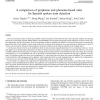Free Online Productivity Tools
i2Speak
i2Symbol
i2OCR
iTex2Img
iWeb2Print
iWeb2Shot
i2Type
iPdf2Split
iPdf2Merge
i2Bopomofo
i2Arabic
i2Style
i2Image
i2PDF
iLatex2Rtf
Sci2ools
SPEECH
2008
2008
A comparison of grapheme and phoneme-based units for Spanish spoken term detection
The ever-increasing volume of audio data available online through the world wide web means that automatic methods for indexing and search are becoming essential. Hidden Markov model (HMM) keyword spotting and lattice search techniques are the two most common approaches used by such systems. In keyword spotting, models or templates are defined for each search term prior to accessing the speech and used to find matches. Lattice search (referred to as spoken term detection), uses a pre-indexing of speech data in terms of word or sub-word units, which can then quickly be searched for arbitrary terms without referring to the original audio. In both cases, the search term can be modelled in terms of sub-word units, typically phonemes. For in-vocabulary words (i.e. words that appear in the pronunciation dictionary), the letter-to-sound conversion systems are accepted to work well. However, for out-ofvocabulary (OOV) search terms, letter-to-sound conversion must be used to generate a pronunci...
| Added | 15 Dec 2010 |
| Updated | 15 Dec 2010 |
| Type | Journal |
| Year | 2008 |
| Where | SPEECH |
| Authors | Javier Tejedor, Dong Wang, Joe Frankel, Simon King, José Colás |
Comments (0)

